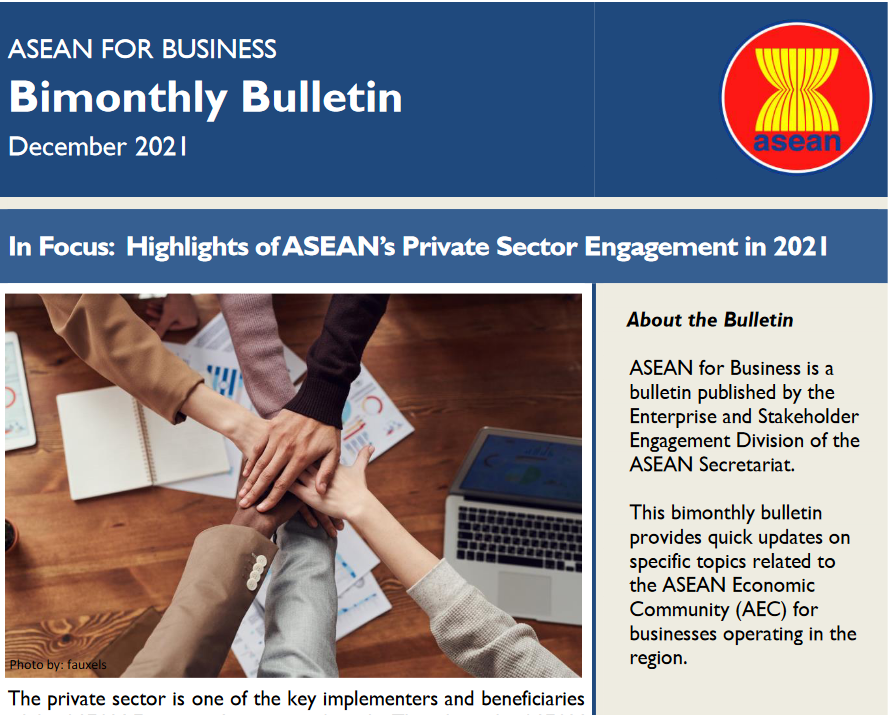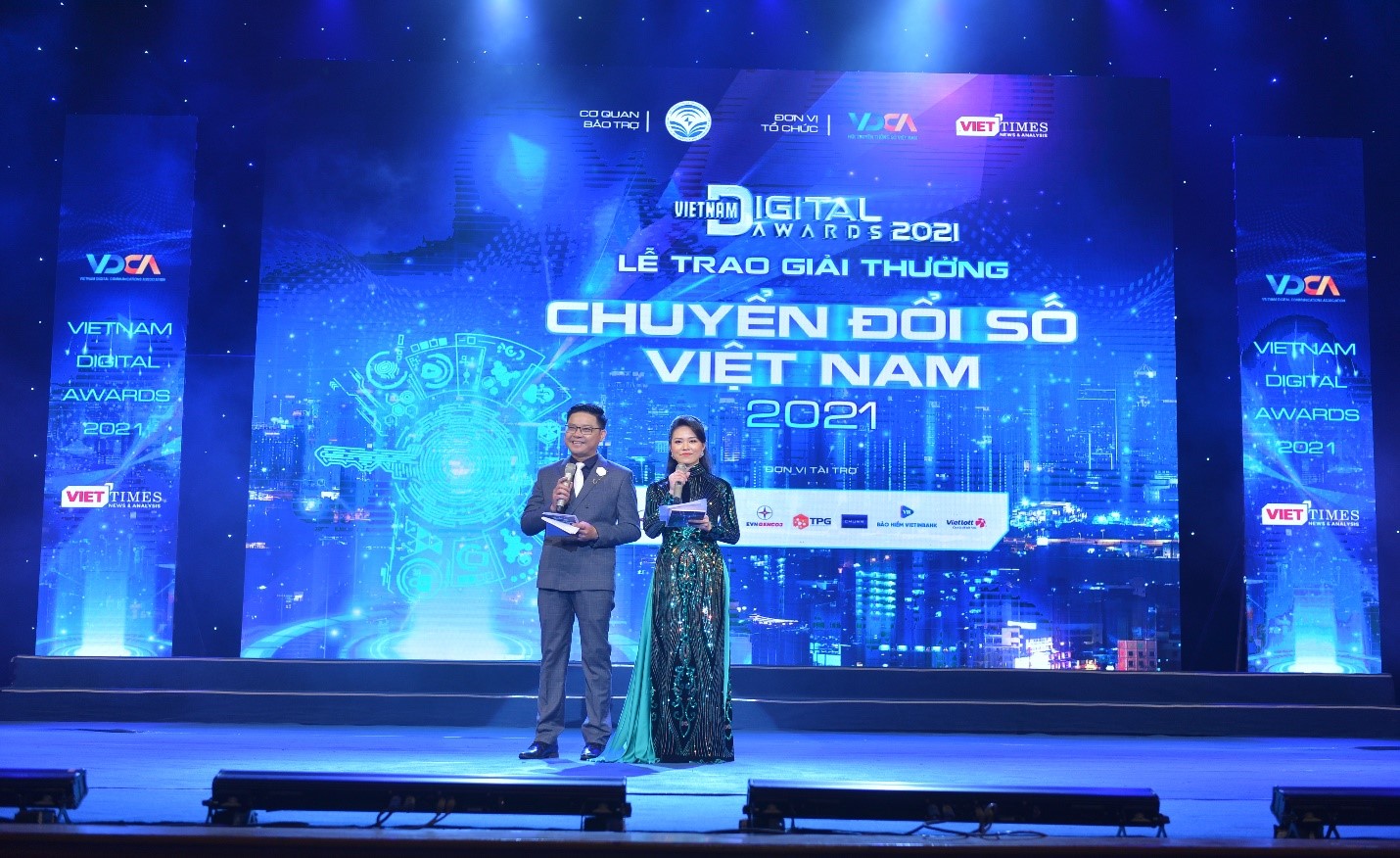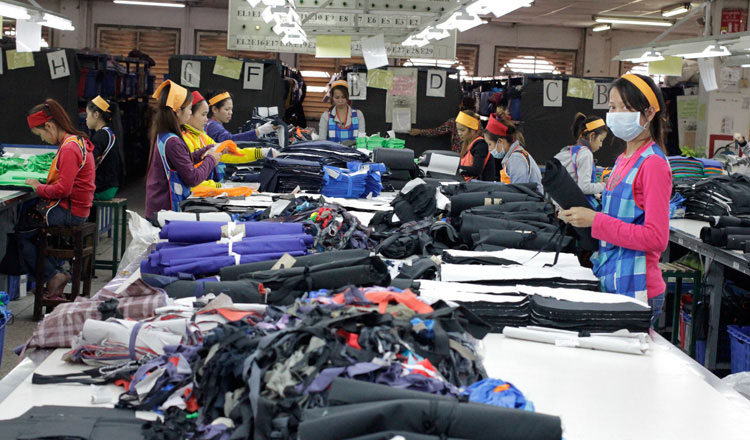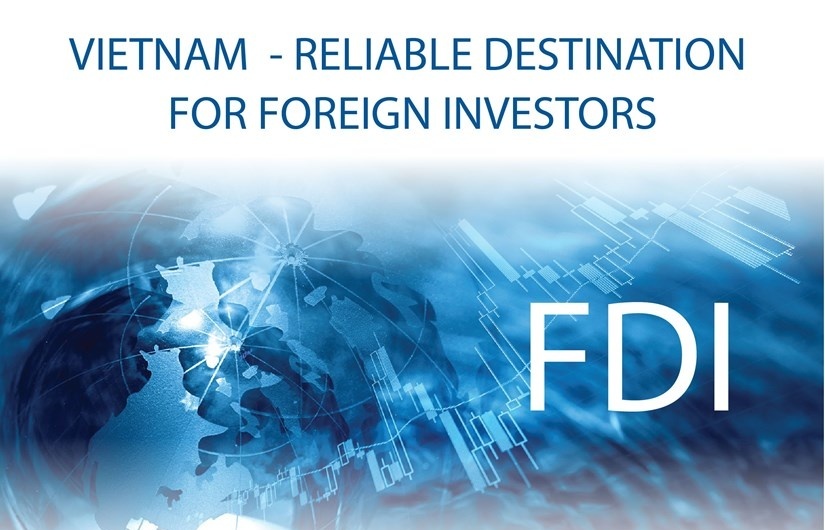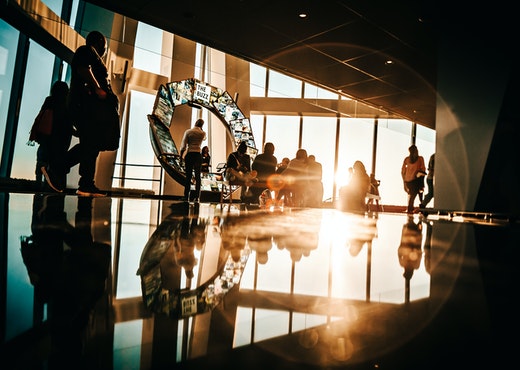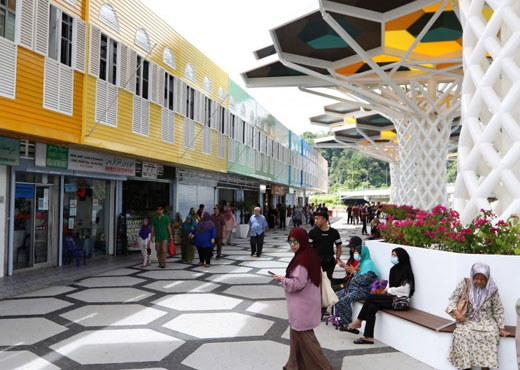One hundred fifteen engagements between the private sector and ASEAN sectoral bodies as well as the ASEAN Secretariat took place from January to mid-November 2021, marking an increase of 64% compared to the engagements held in 2020. This December issue of ASEAN for Business Bimonthly Bulletin highlights the private sector's involvement and contribution to building the ASEAN Economic Community (AEC) in 2021.
Laos has officially announced it will reopen for tourism on 1 January 2022, providing more information on travel conditions during a press conference held at the Lao National Convention Center today.
According to the Ministry of Information, Culture, and Tourism, the reopening will be implemented in three phases.
The first phase will be from 1 January to 30 March 2022, the second phase from 1 April 2022 to 30 June 2022, and the third phase from 1 July 2022 onward.
According to the ministry, tourists from an initial list of countries will be allowed to travel to the country during the first phase.
The list of countries includes China, Vietnam, Cambodia, Thailand, Malaysia, Singapore, South Korea, Japan, France, United Kingdom, Germany, the Netherlands, Spain, Italy, United States, Canada, and Australia.
Tourism will be restricted to group tours at first, with tours arranged by authorized tour operators under the Lao Travel Green Zone Plan.
Tourists will be required to have been fully vaccinated against Covid-19 no less than 14 days prior to arrival. Other conditions include a health insurance policy with coverage no less than USD 50,000 and a negative RT-PCR test taken within the last 72 hours.
Arrivals will be tested for Covid-19 and placed in a 24-hour quarantine in their hotel until a negative result is found.
Tourists will be required to download and register via the LaoKYC and the LaoStaySafe mobile applications prior to arriving in the country, as well as uploading their relevant vaccination certification and Covid-19 test results...
Source: Laotian Times
cr: laotiantimes.
KUALA LUMPUR, December 11 – SME and Entrepreneurs Business Awards (SEBA), an annual initiative organised by Yayasan Usahawan Malaysia that aims to recognise Malaysia’s most notable companies and entrepreneurs, is back once again. In partnership with Celcom Business, Yayasan Usahawan Malaysian hosted their 6th Grand Awards Gala Evening on the 9th of December 2021, at the Shangri-La Hotel, Kuala Lumpur.
Over 350 guests attended the event to witness the unveiling of this year’s most outstanding entrepreneurs, SMEs and businesses. Among the many that attended the gala dinner were Tan Sri Noh Haji Omar, Minister of Entrepreneur Development and Cooperatives (MEDAC), Dato’ Suriani Ahmad, Secretary General of MEDAC, and all the Board of Advisors of SEBA 2021. A total of 42 prestigious awards were presented to various SMEs and entrepreneurs hailing from numerous industries.
In line with the external challenges that many businesses have had to experience recently, this year’s event was themed, ‘Thriving the Waves’. SEBA believes this period of emergence from the pandemic is the best time to recognise businesses that have thriving despite the many obstacles. Among the award recipients at the Gala Evening, Dato’ Sri Hajah Siti Nurhaliza Binti Tajuddin was awarded the Entrepreneur of The Year Award, Mr. Shahrul Anuar Bin Zain was presented with the Lifetime Achievement Award in the Music Industry, and Mr. Leslie Gomez, from the Olive Tree Group was awarded with the title Excellence in Leadership.
In his welcoming speech, Tan Sri Noh Haji Omar, Minister of MEDAC said, “Yayasan Usahawan Malaysia recognises entrepreneurs who have succeeded in cementing their names within their respective industries and simultaneously elevating Malaysia in the global arena. This is a commendable effort and must be collectively supported.” He further added, “I believe this is a good starting point for entrepreneurs who are bravely facing the challenges on the road to success.
MEDAC is confident that the vision and mission of achieving an entrepreneurial nation will succeed with the cooperation and teamwork from various backgrounds in line with the concept of Keluarga Malaysia. On behalf of the Ministry of Entrepreneur Development and Cooperatives, I call on all Malaysian families to unite with a concerted effort to restore the Malaysian economy which has been impacted by COVID-19. Hopefully, the efforts made by Yayasan Usahawan Malaysia, will continue to be a catalyst for other entrepreneurs to successfully navigate the efforts that have been carried out.
During SEBA 2021, Yayasan Usahawan Malaysia also officially launched their e-magazine, “Asia Connects”. The publication aims to create an enhanced platform for further regional growth prospects as we move towards a post pandemic recovery. This year, SEBA added several new categories, starting with the Halal-preneur Award and the Young Entrepreneur Award. Aiming to adapt and evolve with the times, and as the halal sector is a rising segment within the industry, for the first time, SEBA will be honouring entrepreneurs who have successfully empowered their community in general, within the Halal sector. On the other hand, the Young Entrepreneur Award is designed to empower the youths of today and encourage early entrepreneurship in the community.
On 9th December 2021, the Vietnam Digital Awards 2021 was jointly held by Vietnam Digital Communication Association and eMagazine VietTimes . The Agency for Enterprise Development – Ministry of Planning and Investment has been honored “ Outstanding digital transformation state agencies, public units ” with the Business Portal at www.business.gov.vn.
The landmark railway has seen Laos transform from a landlocked country to a land-linked nation, opening up new opportunities for trade and travel.
Lao President Thongloun Sisoulith spoke during a live broadcast from the National Cultural Hall, while invited guests attended the launch of the railway at Vientiane Station.
At the same time, President Xi Jinping was broadcast from Beijing, while a train stood ready to depart from Xishuangbanna Railway Station, in Kunming.
“This ceremony marks a monumental and historic milestone in the development of modern infrastructure for Laos. It’s a proud moment for the Lao people to realize this dream,” said President Thongloun Sisoulith.
He said that the Laos-China Railway is a wonderful gift for the Lao people on the occasion of its National Day, and that the railway would bring about new conditions for the comprehensive development of Laos.
Read for the full article HERE
The Cambodia Chamber of Commerce and the Philippine Chamber of Commerce have agreed to promote and strengthen business and economic cooperation.
The two parties signed a Memorandum of Understanding recently. Kith Meng, President of Cambodia Chamber of Commerce and AMB. Benedicto V. Yujuico, President of the Philippine Chamber of Commerce were the signatories.
The virtual MoU signing was held during the 3rd Meeting of the Cambodia-Philippines Joint Commission for Bilateral Cooperation (JCBC) and witnessed by Prak Sokhonn, Deputy Prime Minister, Minister of Foreign Affairs and International Cooperation and Honorable Teodoro L. Locsin Jr., Secretary of Foreign Affairs of the Republic of the Philippines.
The MoU is aimed to promote and strengthen business and economic cooperation between Cambodia and the Philippines in various fields such as ICT and innovation, agriculture, manufacturing, franchising, tourism, services, and SME development, read a press release.
“Both chambers will regularly exchange information, organise trade and investment mission, hold seminar and conferences, organise exhibitions and arrange business matchings,” it added.
Both chambers agreed to establish a Philippines-Cambodia Business Council based in the Philippines and Cambodia-Philippines Business Council in Cambodia that will meet to discuss, plan, and implement joint initiatives.
For full article, please read here
Author: Chea Vannak – AKP
Source: Khmer Times
Publication date: 8 December 2021
The Cambodian government has pushed for more products for exports as the country is opening wider markets after free trade agreements and the Regional Comprehensive Economic Partnership Agreement come into force earlier next year.
Speaking at the inauguration ceremony of the national road number 7 on Monday, Prime Minister Hun Sen said that the Cambodia-China Free Trade Agreement and the Regional Comprehensive Economic Partnership Agreement, which will enter into force in January 2022, will further improve Cambodia’s economic performance.
The two agreements, which will take effect in January, will open up a wider market for Cambodian products to boost exports, he said.
“The free trade agreement between Cambodia and China will enter into force in January, RCEP will enter into force in January as well, so Cambodia has a better leverage to try and produce to promote exports, this is a positive turning point for the Cambodian people,” Mr Hun Sen said.
The Free Trade Agreement (FTA) is a mutual tax exemption agreement between one country and another on agreed products. It is not only a product tax exemption agreement, but covers many areas, including services, investment, trade facilitation and the removal of non-tariff barriers.
For full article, please read here
Author: Chea Vanyuth
Source: Khmer Times
Publication date: 07 December 2021

Huawei Technologies (Thailand) Co., Ltd., in cooperation with Bangkok Post Public Company Limited, ASEAN Foundation, and over 60 ICT industry partners across Thailand, organised “Powering Digital Thailand 2022: Huawei Cloud & Connect” in conjunction with Asia-Pacific Innovation Day, in a hybrid format comprising onsite exhibitions and online broadcast from 17-19 November 2021, at Convention Centre, 22nd floor, Centara Grand at CentralWorld.
Carrying on the same theme from last year and featuring many keynote industry speakers, exhibitions, and a hands-on lab, the event delves into how digital technologies can unlock new potentials, markets, and business models while also supporting post-pandemic economic recovery in Thailand and the Asia Pacific region. Furthermore, it thoroughly explores practical applications of Cloud, 5G, AI, and Digital Power technologies in industries through digital transformation, especially Thailand’s agriculture, manufacturing, and renewable energy sectors.
In a welcome speech by Guo Ping, Huawei Rotating Chairman, he expressed his strong belief in post-pandemic economic recovery and digital economic growth in the region, saying, “Digital technology, especially 5G, Cloud, and AI, will surely become a pillar for economic recovery and resilience in many countries. We plan to invest $100 million over the next three years to help build a startup ecosystem in the region. We believe all countries in the Asia Pacific region will succeed in their push to go digital. We will extend our roots deeper and do our part during the region’s ten golden years of digital transformation.”
General Prawit Wongsuwon, Deputy Prime Minister, opened the event, stating that, “Digital technology is crucial to Thailand’s digital economic development, post-pandemic recovery, and social well-being. The collaboration between government and industry to integrate technologies and move the country forward will enhance business potential, government efficiency, and Thailand’s sustainability.” Chaiwut Thanakamanusorn, Minister of Digital Economy and Society, said, “Under strong policies to develop the national digital economy and technology, Thailand’s digital infrastructure and data economy have taken great strides in the past several years. We believe that Thailand’s digital economy can reach 30% of the country’s GDP by 2030, or even earlier. In this endeavour, we look forward to continue working with Huawei and deepen our collaboration to use innovation in promoting Thailand’s digital economy.”
Lin Baifeng, President of Huawei Asia Pacific, emphasised that, “As one of the most populous and diverse regions in the world, Asia Pacific is marching to the forefront of the global digital landscape. With over 20 years of partnership with and contributions to the region, Huawei is committed to supporting Thailand and the region’s digital vision in three key areas: Connectivity and Intelligence, Low-Carbon Development, and Digital Inclusion Initiatives.”
Dr. Le Quang Lan, Assistant Director, Head of ICT and Tourism Division, ASEAN Secretariat, commented on the Asia-Pacific Innovation Day activity, “The power of digital economy lies in its ability to enable companies to scale their business models throughout the region, and a common approach for digital transformation should be adopted throughout the Asia Pacific region.” Abel Deng, CEO of Huawei Technologies (Thailand) Co., Ltd., addressed digital transformation trends and Huawei’s mission in the Thai market, saying, “We are inspired to see Thailand become a leading digital force in the ASEAN region. Huawei is fully committed to supporting Thailand in becoming ASEAN’s low-carbon leader, and we are confident of achieving this goal together.”
In the event, discussions through the perspectives of various industry leaders echoes the spirit of technology transformation and empowerment, covering Thailand industry 4.0 in the post pandemic era, low-carbon business, digital economy, digital content production, digital healthcare, financial service innovation, digital education, digital tech ecosystem, disruptive retail , autonomous and AI solutions, and carbon neutrality.
One of the most exciting innovations showcased at the event is Huawei’s introduction of its Digital Power Business to Thailand. The showcase focuses on developing clean energy to replace fossil fuels through digital and power electronics technology and driving low-carbonisation, electrification, and intelligentalisation such as Smart PV & Battery Energy Storage, Intelligent EV Charging Network, Smart Data Center Facility, and Green Site Power Facility. Currently, it is providing services to over 1000 customers and partners in Thailand.
Another highlight of the exhibition component of the event is Cloud Tractor Training, where visitors can experience a tractor training course enabled by a low-latency 5G network and cloud rendering server. This innovation can be implemented by Thai farmers to improve and optimise their cultivation of agricultural produce.
The event is also highlighting inspiring business cases and solutions related to digital transformation. This includes how to develop a green, low-carbon, and open ecosystem split across three areas. The first area is “Redefine Infrastructure” which showcases how 5G, Cloud, and AI technologies can converge across all industries to unleash new value. The second area focuses on “Industry Digital Transformation” including Smart Transportation, Smart Campus, and Smart Finance. The third area exhibits major global partners and businesses that are collaborating with Huawei to build a prosperous ecosystem for the intelligent era.
Another event highlight is the Intelligent World 2030 White Paper which cites upcoming technological trends from Huawei to look out for, including Cloud, 5G Bullet Time, Cloud and 5G VR Gaming, Smart Healthcare, Smart Finance, and Smart Education.
For IT managers, cloud engineers, data scientists, developers, and solution architects, Huawei Cloud experts organised the hands-on lab course offering technical and practical sessions as well as skills development workshops for deploying and operating cloud computing technology. The topics include cloud container engine, AI and machine learning, enterprise intelligence and data platform, and service migration.
Finally, the second Huawei Cloud Developer Competition in Thailand was showcased at the event under the theme of “Creating value for Thailand and society; for a better future for this beautiful country.”
Source: The Bangkok Post
BANDAR SERI BEGAWAN – Non-essential travel will be allowed once 80 percent of the population has been vaccinated for COVID-19, the minister of home affairs said Wednesday.
This means residents will be allowed to leave the country for holiday travel and the sultanate will also reopen its borders to tourists.
However, residents will only be able to travel to places on a ‘green list’, comprising of countries considered low risk for COVID-19, YB Pehin Dato Dr Hj Abu Bakar Hj Apong told reporters after the daily COVID presser.
Brunei is likely to hit the 80 percent target by early December, known as the ‘endemic phase’ of the government’s COVID-19 recovery plan.
The endemic phase will see the opening of air travel, but the reopening of land and the sea borders depends on the COVID situation in Brunei’s neighbouring countries, the home affairs minister added.
Brunei has severely restricted inbound and outbound travel since March last year, with essential travelers needing to apply for an entry or exit permit from the Prime Minister’s Office.
Read the full article here.

